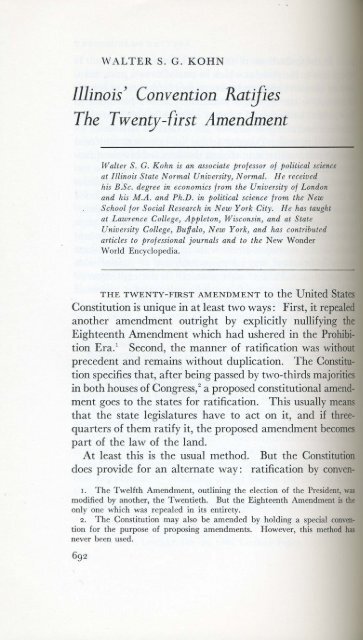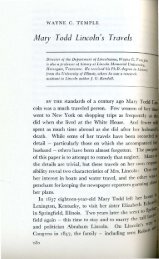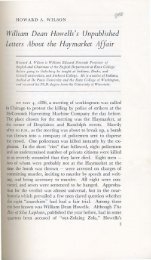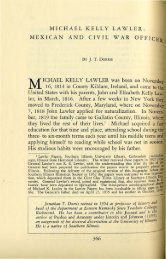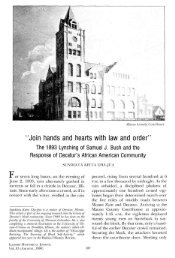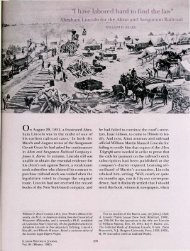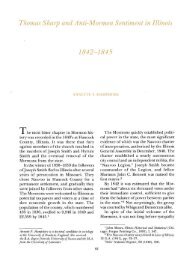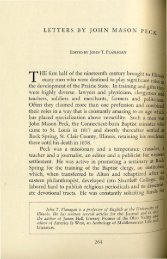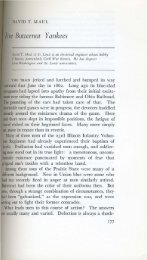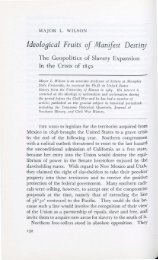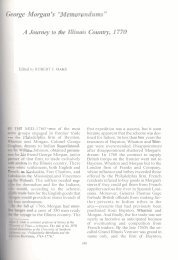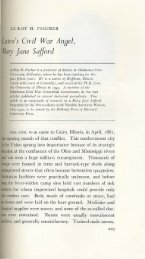Convention Ratifies the Twenty-first Amendment
Convention Ratifies the Twenty-first Amendment
Convention Ratifies the Twenty-first Amendment
Create successful ePaper yourself
Turn your PDF publications into a flip-book with our unique Google optimized e-Paper software.
w ALTER S. G. KOHN<br />
Illinois' <strong>Convention</strong> <strong>Ratifies</strong><br />
The T wenty-flrst <strong>Amendment</strong><br />
Walter S. C. Kohn is an associate professor of political science<br />
at Illinois State Normal University, Normal. He received<br />
his B.Sc. degree in economics from <strong>the</strong> University of London<br />
and his M.A. and Ph.D. in political science from <strong>the</strong> New<br />
School for Social Research in New York City. He has taught<br />
at Lawrence College, Appleton, Wisconsin, and at State<br />
University College, Buffalo, New York, and has contributed<br />
articles to professional journals and to <strong>the</strong> New Wonder<br />
World Encyclopedia.<br />
THE TWENTY- FIRST AMENDMENT to <strong>the</strong> United States<br />
Constitution is unique in at least two ways: First, it repealed<br />
ano<strong>the</strong>r amendment outright by explicitly nullifying <strong>the</strong><br />
Eighteenth <strong>Amendment</strong> which had ushered in <strong>the</strong> Prohibition<br />
Era.' Second, <strong>the</strong> manner of ratification was without<br />
precedent and remains without duplication. The Constitution<br />
specifies that, after being passed by two-thirds majorities<br />
in both houses of Congress,2 a proposed constitutional amendment<br />
goes to <strong>the</strong> states for ratification. This usually means<br />
that <strong>the</strong> state legislatures have to act on it, and if threequarters<br />
of <strong>the</strong>m ratify it, <strong>the</strong> proposed amendment becomes<br />
part of <strong>the</strong> law of <strong>the</strong> land.<br />
At least this is <strong>the</strong> usual method. But <strong>the</strong> Constitution<br />
does provide for an alternate way: ratification by conven-<br />
I. The Twelfth <strong>Amendment</strong>, outlining <strong>the</strong> election of <strong>the</strong> President, was<br />
modified by ano<strong>the</strong>r, <strong>the</strong> Twentieth. But <strong>the</strong> Eighteenth <strong>Amendment</strong> is <strong>the</strong><br />
only one which was repealed in its entirety.<br />
2 . The Constitution may also be amended by holding a special convention<br />
for <strong>the</strong> purpose of proposing amendments. However, this method has<br />
never been used.
WALTER S. G. KOHN<br />
tions in three-quarters of <strong>the</strong> states. Congress may propose<br />
one or <strong>the</strong> o<strong>the</strong>r mode of ratification, and only once has it<br />
chosen <strong>the</strong> convention method: in <strong>the</strong> case of what became<br />
<strong>the</strong> <strong>Twenty</strong>-<strong>first</strong> <strong>Amendment</strong> repealing prohibition.<br />
There are indications that this method was selected because<br />
some state legislators who may have wished to vote<br />
for ratification might not have had <strong>the</strong> courage of <strong>the</strong>ir<br />
convictions if by doing so <strong>the</strong>y would incur <strong>the</strong> wrath of <strong>the</strong>ir<br />
constituents. This fear was not well founded in view of <strong>the</strong><br />
overwhelming support given almost everywhere by <strong>the</strong> electorate<br />
to <strong>the</strong> repeal proposal. However, it was regarded<br />
as safer to let <strong>the</strong> decisive votes be cast by an entirely different<br />
group of people.<br />
Both political parties, in <strong>the</strong>ir platforms adopted at <strong>the</strong><br />
national party conventions in <strong>the</strong> summer of I932, came<br />
out for repeal by convention, which in itself was a reversal<br />
of <strong>the</strong> position <strong>the</strong>y had taken four years earlier. One argument<br />
for such a course was that special conventions would<br />
avoid delay by state legislatures, and by prompt action would<br />
help to put <strong>the</strong> bootleggers' profit into <strong>the</strong> Federal treasury<br />
and thus "balance <strong>the</strong> Budget, secure government against<br />
<strong>the</strong> possibility of bankruptcy, and relieve <strong>the</strong> people of fur<strong>the</strong>r<br />
additions to <strong>the</strong> already intolerable burden of taxation."3<br />
On <strong>the</strong> o<strong>the</strong>r hand, people like Congressman Gifford<br />
from Massachusetts feared constitutional conventions because<br />
"<strong>the</strong>re may not be a limit to <strong>the</strong> powers of <strong>the</strong> members<br />
<strong>the</strong>reof to meddle with <strong>the</strong>ir own State constitution." In<br />
o<strong>the</strong>r words, once called toge<strong>the</strong>r, would such a convention<br />
know where to stop? Gifford specifically mentioned Illinoisans<br />
as hesitating "because of <strong>the</strong> mischief, as <strong>the</strong>y regard<br />
it, that may be done to <strong>the</strong>ir own organic law, and [<strong>the</strong>y]<br />
have attempted to place limitations on <strong>the</strong> action of such<br />
conventions."4 To set aside precisely such fears <strong>the</strong> plat-<br />
3. A. Mitchell Palmer, who had served as attorney general under President<br />
Wilson, in a brief inserted in <strong>the</strong> Congressional Record, LXXVI (Dec.<br />
7, 1932): 133·<br />
4. Congressional Record, (Dec. 8, 1932): 225.
ILLINOIS' CONVENTION<br />
forms of both parties had stipulated special conventions<br />
whose "sole purpose" (Republicans) it was to "act solely"<br />
(Democra ts) on <strong>the</strong> repeal amendment. 5<br />
At any rate, in February, 1933, <strong>the</strong> proposed <strong>Twenty</strong>-<strong>first</strong><br />
<strong>Amendment</strong> passed <strong>the</strong> United States Senate by a vote of<br />
63 to 23,6 a.nd <strong>the</strong> House of Representatives by 289 to 121.'<br />
Both senators from Illinois, a Republican and a Democrat,<br />
voted for <strong>the</strong> amendment. At that time Illinois had twentyseven<br />
members in <strong>the</strong> House. One Democrat had died on<br />
November 6 and <strong>the</strong> vacancy remained unfilled. The o<strong>the</strong>r<br />
twelve Democrats voted for <strong>the</strong> proposed amendment. Of<br />
<strong>the</strong> Republicans, three did not vote, five were for it, and six<br />
against. That only Republicans cast negative votes is not<br />
in itself remarkable. But this was not <strong>the</strong> Congress elected<br />
in <strong>the</strong> fall of 1932; its members were "lame ducks" who had<br />
been elected two years earlier. The congressmen from Illinois<br />
who supported <strong>the</strong> repeal amendment or abstained had<br />
ei<strong>the</strong>r been re-elected in November, 1932, or ano<strong>the</strong>r memo<br />
ber of <strong>the</strong>ir party had been victorious. But every single one<br />
of <strong>the</strong> six congressmen who were recorded as voting against<br />
it had been defeated more than three months earlier!<br />
On February 21 , 1933, Secretary of State Henry L. Stimson<br />
sent identical letters to <strong>the</strong> governors of all states in·<br />
forming <strong>the</strong>m of <strong>the</strong> repeal amendment as passed by Congress<br />
and requesting its submission to a state convention. 8 Thus<br />
<strong>the</strong> ball was tossed to <strong>the</strong> individual states who apparently<br />
were to handle <strong>the</strong> details in whatever way <strong>the</strong>y saw fit. 9<br />
Georgia, Kansas, Louisiana, Mississippi, and North Dakota<br />
decided that discretion was <strong>the</strong> better part of valor and did<br />
5· I bid., (D ec. 7,1932): 131.<br />
6. Illinois State Journal (Springfield ) , Feb. 17, 1933, p. 1.<br />
7· Ibid., Feb. 21, 1933, p. I. It is interesting to note that in 1917 <strong>the</strong><br />
vote for <strong>the</strong> Eighteenth <strong>Amendment</strong> was almost <strong>the</strong> same: 65 to 20 in <strong>the</strong><br />
Senate and 282 to 128 in <strong>the</strong> House. See H erbert Asbury, The Great Illusion<br />
(Garden City, N. Y., 1950 ) ,325.<br />
8. Everett S. Brown, "Ratification of <strong>the</strong> <strong>Twenty</strong>-<strong>first</strong> <strong>Amendment</strong>,"<br />
American Political Science R eview, XXIX (Dec., 1935): ro05-6.<br />
9. Some legislation providing for unified procedure throughout <strong>the</strong> states<br />
was introduced in Congress but never got anywhere.<br />
694
WALTER S. G. KOHN<br />
nothing. North Carolina left it up to <strong>the</strong> people, who voted<br />
against holding a convention while, at <strong>the</strong> same time, choosing<br />
delegates who would have attended if such a convention<br />
had been held! Nebraska, Montana, Oklahoma, and South<br />
Dakota did not want to rush into anything and made preparations<br />
to hold conventions in 1934, by which time, as it<br />
turned out, any action on <strong>the</strong>ir part had become unnecessary<br />
since <strong>the</strong> required number of ratifications had already been<br />
obtained and <strong>the</strong> amendment adopted. 10<br />
In Illinois <strong>the</strong>re were reports that <strong>the</strong> General Assembly ·<br />
might constitute itself into a state convention. This apparently<br />
was <strong>the</strong> outcome of a conference between five leading<br />
legislators and Democratic Governor Henry Horner. These<br />
men were quoted as saying that <strong>the</strong>y could not find anything<br />
in state or federal laws to prevent this action. ll (Presumably<br />
if a legislative body can turn itself into a committee of <strong>the</strong><br />
whole, it could also turn <strong>the</strong> magic trick and constitute itself<br />
into a convention. ) At any rate, <strong>the</strong> General Assembly was<br />
said to be "wet in sentiment" and in favor of ratification. 12<br />
This view is challenged by Fletcher Dobyns who, in a book<br />
published seven years later, maintains that <strong>the</strong> legislatures<br />
would never have passed <strong>the</strong> amendment, for only in statewide<br />
elections could <strong>the</strong> city "with its wealth, daily newspapers,<br />
political machines, underworld and o<strong>the</strong>r resources"<br />
overwhelm <strong>the</strong> rest of <strong>the</strong> state, leaving <strong>the</strong> "dry" delegates<br />
without protection. "Bipartisan rings of crooked politicians<br />
could <strong>the</strong>n control <strong>the</strong> polls, count <strong>the</strong> votes, make <strong>the</strong> return<br />
and deliver <strong>the</strong> goods. 1l13<br />
Be that as it may, <strong>the</strong> suggestion that <strong>the</strong> Illinois legislature<br />
be transformed into a repeal convention seems to have<br />
died a quiet death. Instead, at <strong>the</strong> proposal of Democratic<br />
floor leader Thomas P. Sinnett,14 a committee of five state<br />
10. Brown, "Ratification of <strong>the</strong> <strong>Twenty</strong>-<strong>first</strong> <strong>Amendment</strong>," 1006.<br />
I L New York Times, Feb. 22, 1933, p. 16.<br />
12. Ibid.<br />
13. Fletcher Dobyns, The Amazing Story of R epeal: An Expose of <strong>the</strong><br />
Po wer of Propaganda (Chicago, 1940), 45-46.<br />
14· Illinois State .Tournai (Springfield), Feb. 22, 1933, p. L<br />
695
ILLINOIS' CONVENTION<br />
senators and five state representatives was appointed to<br />
"recommend to <strong>the</strong> General Assembly <strong>the</strong> course of procedure<br />
to be followed for calling a State convention to act<br />
upon such proposed amendment.'>15 There was disagreement<br />
about some of <strong>the</strong> details. For a while it appeared<br />
that delegates to <strong>the</strong> convention might be chosen at <strong>the</strong> next<br />
state-wide primaryI 6 which would have meant postponement<br />
of any action until April, 1934. This met with strong objections<br />
from <strong>the</strong> Governor who wanted prompt action to<br />
redeem campaign pledges.17<br />
The number of delegates also caused some arguments.<br />
Once again, each state followed its own whims. Indiana<br />
decided on <strong>the</strong> largest number, 329, followed by New Jersey<br />
with 226 and New York with ISO convention members. On<br />
<strong>the</strong> opposite end of <strong>the</strong> scale, Arizona and Vermont decided<br />
on fourteen delegates, New Hampshire on ten and New<br />
Mexico figured that three was sufficient. IS New Mexico<br />
had enacted <strong>the</strong> provision that <strong>the</strong> number of convention<br />
members should be <strong>the</strong> same as <strong>the</strong> number of its presidential<br />
electors. And so two men and one woman met at noon on<br />
September 19, 1933 in <strong>the</strong> senate chamber at Santa Fe. In<br />
an outburst of gallantry, <strong>the</strong>y elected Mrs. Franklin 1. Lane<br />
as <strong>the</strong>ir chairman, named Prager Miller secretary, and <strong>the</strong>n<br />
<strong>the</strong> convention of three adjourned for lunch. At 2: 30 P.M.<br />
this "body" solemnly voted three to none in favor of ratification<br />
of <strong>the</strong> <strong>Twenty</strong>-<strong>first</strong> <strong>Amendment</strong>, <strong>the</strong> document being<br />
signed by <strong>the</strong> two officers of <strong>the</strong> convention and Miguel A.<br />
Gonzales, delegate. 19<br />
The nation-wide average came to about sixty delegates<br />
per state convention. Since Illinois at that time was divided<br />
15· Journal of <strong>the</strong> Illinois House of Representatives, 58 G.A., 260. Re·<br />
printed in <strong>the</strong> Proceedings of <strong>the</strong> Illinois "Repeal <strong>Convention</strong>," 8.<br />
16. Illinois State Journal, April 18, 1933, p. I.<br />
17· Ibid., April 23, 1933, p. 9.<br />
18. Brown, "Ratification of <strong>the</strong> <strong>Twenty</strong>-<strong>first</strong> <strong>Amendment</strong>," 1006.<br />
19. Everett S. Brown, "State <strong>Convention</strong> R ecords and Laws," Law, VII<br />
(University of Michigan, 1938): 290-9 I.<br />
696
WALTER S. G. KaHN<br />
into twenty-five congressional districts,20 twenty-five was<br />
sometimes mentioned as a suitable number for <strong>the</strong> state. 21<br />
On April 3, 1933, Michigan elected its one hundred convention<br />
delegates. This was done by districts with <strong>the</strong> result<br />
that victory went to 99 "wets" and one "dry," Dr. Eugene<br />
Davenport, retired dean of agriculture at <strong>the</strong> University of<br />
Illinois. 22 On April II this group met and voted 99 to one<br />
in favor of ratification of <strong>the</strong> <strong>Twenty</strong>-<strong>first</strong> <strong>Amendment</strong>, thus<br />
making Michigan <strong>the</strong> <strong>first</strong> state to do SO.23 Apparently now<br />
Illinoisians felt that <strong>the</strong>y did not want to be left behind.<br />
After <strong>the</strong> state senate session was opened with a prayer by<br />
<strong>the</strong> former president of <strong>the</strong> Illinois Anti-Saloon League,24<br />
<strong>the</strong> General Assembly on April 28 passed a comprehensive<br />
law, stipulating details of <strong>the</strong> proposed convention. 25 The<br />
latter was to be held at noon of July 10 in <strong>the</strong> House chamber<br />
of <strong>the</strong> General Assembly in <strong>the</strong> capitol building in <strong>the</strong> state<br />
capital of Springfield with <strong>the</strong> governor calling it to order.<br />
Fifty delegates were to be elected at large on June 5, <strong>the</strong> day<br />
on which five state supreme court justices and all <strong>the</strong> circuit<br />
justices were to be elected. A delegate had to be twenty-five<br />
years old, a citizen of <strong>the</strong> United States and a resident of<br />
Illinois for at least five years. Nomination was to be by<br />
petition, with 25,000 signatures necessary for a place on <strong>the</strong><br />
ballot. The names of <strong>the</strong> candidates for delegates were to<br />
be in columns under <strong>the</strong> headings "For Ratification,"<br />
"Against Ratification," and "No Preference Expressed."<br />
The last one, as it turned out, did not materialize, since all<br />
would-be delegates ran ei<strong>the</strong>r on <strong>the</strong> pro-ratification slate or<br />
in opposition to it. Any decision at <strong>the</strong> convention was to<br />
be made by majority vote!6<br />
20. Two Congressmen from Illinois were elected at large.<br />
21. Illinois State Journal, Feb. 23, 1933, p. I.<br />
22. Ibid., April 10, 1933, p. I.<br />
23. Ibid., April I I, 1933, p. I.<br />
24· Ibid., April 27, 1933, p. 2.<br />
25· Journdl of <strong>the</strong> Illinois House of Representatives, 58 G.A., 819. Reprinted<br />
in <strong>the</strong> Proceedings of <strong>the</strong> Illinois "Repeal Con vention," 9-14.<br />
26. Ibid.
ILLINOIS' CONVENTION<br />
Two thousand five hundred dollars or "so much <strong>the</strong>reof<br />
as may be necessary" was appropriated by <strong>the</strong> Illinois legislature<br />
"for <strong>the</strong> expenses properly incident to <strong>the</strong> convention."27<br />
The delegates <strong>the</strong>mselves, however, were to receive<br />
no compensation, not even reimbursement for <strong>the</strong>ir expenses.<br />
Once again this was handled differently by <strong>the</strong> various states.<br />
The delegates in Maine received a flat rate of $5.00, those<br />
of Nebraska a lump sum of $25. A daily pay scale was set<br />
up in o<strong>the</strong>r states, Utah providing for $4.00 a day, South<br />
Dakota for $5 .00.28<br />
As <strong>the</strong> weeks rolled by toward June 5, hot judicial races<br />
developed in Illinois between <strong>the</strong> two major parties. Despite<br />
this, however, leading Democrats and Republicans alike<br />
were united in <strong>the</strong>ir efforts to elect a ticket favorably disposed<br />
toward ratification. The opponents made a major<br />
effort to show strength by filing 4,527 pages containing<br />
95,704 signatures 29 which was 70,000 more than <strong>the</strong> law required.<br />
But <strong>the</strong>ir ticket was comparatively unbalanced as<br />
far as regional representation was concerned. Fourteen<br />
would-be delegates were from Chicago proper, four each<br />
from suburban Oak Park and Evanston, and one each from<br />
suburban Lake Forest and Wilmette. The <strong>Twenty</strong>-<strong>first</strong><br />
Congressional District, which included Springfield, provided<br />
five would-be delegates. Two congressional districts were<br />
represented by three people each, four o<strong>the</strong>rs by two apiece,<br />
seven by one each and one by nobody. Yet three counties<br />
in <strong>the</strong> nor<strong>the</strong>rn part and one in <strong>the</strong> west of this large rural<br />
eleven-county congressional district - <strong>the</strong> <strong>the</strong>n <strong>Twenty</strong>fourth<br />
- went against ratification while every county of <strong>the</strong><br />
<strong>Twenty</strong>-<strong>first</strong> voted "wet." Of <strong>the</strong> two congressional districts<br />
outside of Chicago and Springfield that had <strong>the</strong> largest representation<br />
on <strong>the</strong> "dry" slate, four out of six counties in<br />
<strong>the</strong> Fourteenth and none in <strong>the</strong> Twelfth Congressional District<br />
went against <strong>the</strong> repeal amendment. About <strong>the</strong> only<br />
27 . Ibid.<br />
28. Brown, "Ratification of <strong>the</strong> <strong>Twenty</strong>-<strong>first</strong> <strong>Amendment</strong>," 1011-12.<br />
29. Illinois State Journal, May 12, 1933, p. 12.<br />
6g8
WALTER S. G. KOHN<br />
conclusion to be drawn from this is that it really did not<br />
make any difference who represented <strong>the</strong> "drys" or where<br />
<strong>the</strong>y were from!<br />
The pro-ratification list, on <strong>the</strong> o<strong>the</strong>r hand, was a masterpiece<br />
of planning. <strong>Twenty</strong>-two of <strong>the</strong> candidates were from<br />
Chicago, one from suburban Lake ·Forest and two from suburban<br />
Cicero, leaving exactly one-half of <strong>the</strong> fifty places to<br />
<strong>the</strong> fifteen down-state congressional districts. All were represented,<br />
ten by two people each, <strong>the</strong> remaining five by one<br />
apiece. Whenever two people came from one congressional<br />
district, one of <strong>the</strong>m was a Democrat and one a Republican,<br />
while <strong>the</strong> one-candidate districts were all represented by<br />
Democrats. This was a good move since every single one<br />
of <strong>the</strong>se districts had gone Democratic in <strong>the</strong> races for <strong>the</strong><br />
national House of Representatives <strong>the</strong> previous November;<br />
besides, <strong>the</strong> Democrats constituted <strong>the</strong> majority party III<br />
Illinois at that time.<br />
The anti-ratification group presented its candidates in<br />
alphabetical order to <strong>the</strong> voters, except that <strong>the</strong> two leading<br />
names were reversed. First place on <strong>the</strong> ballot went to<br />
Henry W. Austin, a sixty-nine-year-old Oak Park banker<br />
who had served a number of terms in both houses of <strong>the</strong><br />
Illinois legislature in earlier years. He thus was fairly well<br />
known. The number two spot was occupied by William P.<br />
Allin of <strong>the</strong> central county of McLean. The only information<br />
that this writer could locate about Allin was in an article<br />
published in <strong>the</strong> local newspaper several years earlier 30 which<br />
chiefly concerned his hobby, taxidermy, and <strong>the</strong> fact that<br />
his farm-house was a museum of rare stuffed birds. The<br />
alphabetical listing of <strong>the</strong> o<strong>the</strong>r forty-eight names gave <strong>the</strong><br />
last place to perhaps <strong>the</strong> most prominent candidate, seventytwo-year-old<br />
Richard Yates, who had held many important<br />
positions in <strong>the</strong> state, such as governor (1901-1905) and<br />
congressman-at-large since 1918, surviving <strong>the</strong> Democratic<br />
landslide of 1930 but not <strong>the</strong> 1932 holocaust. Defeated for<br />
30. Daily Pantagraph (Bloomington), 1926.<br />
699
Richard Yates II, a consistent supporter<br />
of <strong>the</strong> prohibition cause.<br />
re-election in November, 1932, Yates voted against <strong>the</strong> proposed<br />
repeal amendment during <strong>the</strong> "lame-duck" session<br />
in February, 1933, and once more offered his services in <strong>the</strong><br />
cause of prohibition.<br />
Of <strong>the</strong> one hundred candidates competing for <strong>the</strong> fifty<br />
spots on both tickets, this writer was able to identify about<br />
sixty with <strong>the</strong> aid of various Who's W hos, <strong>the</strong> assistance of<br />
a number of very helpful people with excellent memories 31<br />
and several o<strong>the</strong>r sources, including books and newspapers.<br />
The forty persons who remain unknown to <strong>the</strong> writer except<br />
for <strong>the</strong>ir names and addresses may of course represent data<br />
invalidating <strong>the</strong> conclusions reached below. But judging<br />
from <strong>the</strong> information available, <strong>the</strong> anti-ratification candidates<br />
apparently were to a large extent sincere, high-minded,<br />
and often deeply religious people, who, as it turned out, were<br />
politically quite ineffective. Many of <strong>the</strong>m were prominently<br />
identified with <strong>the</strong> Anti-Saloon League or <strong>the</strong> cause<br />
3 1. I should like to single out especially my good friend and colleague,<br />
Dr. J ohn A. Kinneman, emeritus professor of sociology and former chairman<br />
of <strong>the</strong> D epartment of Social Sciences at Illinois State Normal Universit\",<br />
whose assistance in this connection proved of great value. Mrs. H arold Sinclair<br />
of Bloomington was also very helpful in locating useful information.<br />
7 00
WALTER S. G. KOHN<br />
of prohibition and many were Protestant ministers. They<br />
included <strong>the</strong> editor of <strong>the</strong> National Prohibitionist, Edward<br />
Blake; <strong>the</strong> state president of <strong>the</strong> Woman's Christian Temperance<br />
Union, Ada Reed Ferguson; and <strong>the</strong> Prohibitionist<br />
candidate for vice-president of <strong>the</strong> United States in 1932,<br />
Frank Regan of Rockford. The average age of <strong>the</strong> antiratification<br />
candidate was ten years above that of his opponent,<br />
61 Y2 years to 51% years. <strong>Twenty</strong> birth dates were<br />
obtainable from each slate,32 giving <strong>the</strong> following figures:<br />
Anti-ratification Pro-ratification<br />
candidate candidate<br />
at least 35 years but not 40 3<br />
40 45<br />
45 50 5<br />
50 55 2<br />
55 60 4 3<br />
60 65 2 3<br />
65 7 0 7 2<br />
70 75<br />
80<br />
75<br />
80<br />
3 2<br />
The pro-ratification forces left no stone unturned to prove<br />
<strong>the</strong>ir representative character. In addition to <strong>the</strong> Cook<br />
County-downstate balance, <strong>the</strong> proportion of Democrats to<br />
Republicans on <strong>the</strong> slate was representative of <strong>the</strong> party<br />
strength in <strong>the</strong> state. Protestants such as Episcopalian Ralph<br />
Martin Shaw and Baptist Andrew C. Metzger were on <strong>the</strong><br />
ticket. Both were from Chicago; both were Republicans.<br />
There was <strong>the</strong> prominent Jewish corporation lawyer Benjamin<br />
Alschuler from Aurora, a Democrat. Chicago's Bernard<br />
1. Majewski, a member of <strong>the</strong> Knights of Columbus and<br />
<strong>the</strong> Holy Name Society, and Peoria's John E. Cassidy, ano<strong>the</strong>r<br />
member of <strong>the</strong> Knights of Columbus and a graduate<br />
32 . The writer readily admits that a sample of 40 per cent may not give<br />
a completely accurate picture. While later editions of Who's Who and<br />
o<strong>the</strong>r sources were consulted in vain, it is still possible that a number of<br />
those 'unidentified have been too young to be included in some of <strong>the</strong> reference<br />
works. Such are <strong>the</strong> hazards of compiling figures of this sort.
ILLINOIS' CONVENTION<br />
of Notre Dame, attested to <strong>the</strong> religious broad-mindedness<br />
of <strong>the</strong> pro-ratification slate. To <strong>the</strong>ir opponents' ten women<br />
<strong>the</strong> "wets," however, presented only two: Elizabeth A.<br />
Conkey, a public official and commissioner of Cook County,<br />
and at <strong>the</strong> time of this writing Democratic national committeewoman<br />
from Illinois; and Mary Bell Sloan, who had<br />
been an unofficial delegate to <strong>the</strong> World Disarmament Conference<br />
in Geneva in 1931 and who was <strong>the</strong>n married to a<br />
goiter specialist in Bloomington. Even <strong>the</strong> physical needs<br />
of individuals seem to have been properly balanced on <strong>the</strong><br />
pro-ratification side: Oscar Mayer of sausage-making fame<br />
could be paired with Charles M. Postl who had founded<br />
health clubs and health institutes. Incidentally, both of<br />
<strong>the</strong>m were foreign-born, one being a Democrat and a Lu<strong>the</strong>ran,<br />
<strong>the</strong> o<strong>the</strong>r a Republican and a Mason.<br />
The twenty-five candidates from Cook County were listed<br />
<strong>first</strong> on <strong>the</strong> ballot, but no o<strong>the</strong>r order of listing is discernible.<br />
The lead spot was occupied by P. A. Nash, who had just<br />
become Democratic state committeeman. s3 Frequently mentioned<br />
in connection with <strong>the</strong> "Kelly-Nash" or "Horner<br />
Nash" political machines, Nash was undoubtedly one of <strong>the</strong><br />
best-known political figures in Illinois. It had even been<br />
reported 34 that he could have become mayor of Chicago,<br />
but declined because he was already seventy.<br />
The number two position on <strong>the</strong> "wet" ticket was occupied<br />
by George Franklin Harding, described as a "wealthy<br />
real estate man, [who] like his life-long friend [William<br />
Hale] Thompson [whom he helped to become mayor of<br />
Chicago] had <strong>first</strong> entered politics for <strong>the</strong> sport of <strong>the</strong><br />
game."35 Illinois' <strong>first</strong> native son to graduate from Harvard,<br />
an ardent Republican who rose high in Cook County politics,<br />
he held such positions as alderman and comptroller of<br />
33. Nash replaced Anton J. Cermak, fa<strong>the</strong>r-in-law of Illinois' present<br />
Governor Otto Kerner, who had been assassinated by a bullet meant for<br />
President-elect Franklin D. Roosevelt.<br />
34· Illinois State Journal, April 14, 1933, p. I.<br />
35 · William n: Stuart, The T wenty Incredible Y ears (Chicago, 1935 ), 12 .<br />
7 02
WALTER S. G. KOHN<br />
Chicago and was a very powerful figure behind <strong>the</strong> scenes.<br />
Thus he complemented Nash beautifully.<br />
Next on <strong>the</strong> ticket was a Democrat, William L. O'Connell,<br />
Cook County party chairman for many years. He had held<br />
<strong>the</strong> post of chairman of <strong>the</strong> Public Utilities Commission in<br />
1915 and was involved in many presidential campaigns,<br />
though not always on <strong>the</strong> winning side: He was William G.<br />
McAdoo's Illinois manager in 1924, organized <strong>the</strong> state for<br />
Al Smith in 1928, and in 1932 was one of <strong>the</strong> early backers<br />
of Governor Franklin Roosevelt of New York.<br />
The next name on <strong>the</strong> pro-ratification slate was that of<br />
Edward F. Moore, Republican, who had been deputy commissioner<br />
of public works at one time and who was to be<br />
secretary of <strong>the</strong> Cook County Republican committee in 1934<br />
when Harold L. Ickes was read out of <strong>the</strong> Republican Party.<br />
He was surely a man who had <strong>the</strong> courage of his convictions:<br />
Stuart reports that in 1927, when <strong>the</strong>re was a filibuster in<br />
<strong>the</strong> state legislature against a Chicago bond bill, he arrived<br />
in <strong>the</strong> state capital "with many aides. He put cots in <strong>the</strong><br />
House committee rooms, served coffee and sandwiches -<br />
and yes, even good beer, a real treat in those prohibition<br />
days." 36<br />
Moore was followed by Oscar Mayer who has already<br />
been mentioned. Then came Jacob Arvey, who is still a<br />
force in Illinois politics and today occupies <strong>the</strong> position of<br />
Democratic national committeeman from Illinois, Mrs.<br />
Conkey's counterpart. The latter, incidentally, was fifteenth<br />
and Mrs. Sloan was number forty, thus once again illustrating<br />
that <strong>the</strong> women were not specially catered to by <strong>the</strong><br />
"wets"! Arvey was succeeded on <strong>the</strong> ballot by Czech-born<br />
Democrat John Toman who started his American career as<br />
a newsboy at <strong>the</strong> age of ten and rose to serve Chicago in<br />
various capacities, including that of council member. After<br />
<strong>the</strong> prohibition amendment was repealed, he became Cook<br />
County sheriff and treasurer.<br />
36. Ibid., 334.
ILLINOIS' CONVENTION<br />
Republican Judge George Barrett, next on <strong>the</strong> list, was<br />
attorney general of Illinois during <strong>the</strong> Dwight Green administration<br />
in <strong>the</strong> 1940's. Then came two gentlemen who<br />
were in <strong>the</strong> pig iron, ore, and coke business and in plumbing<br />
and sanitary engineering activities, respectively. Only after<br />
<strong>the</strong>se <strong>first</strong> ten prospective delegates is <strong>the</strong>re a name that is<br />
not readily identifiable, thus proving that <strong>the</strong> "wet" slate<br />
attempted to sell itself to <strong>the</strong> electorate as a bi-partisan, starstudded<br />
cast. Far<strong>the</strong>r down <strong>the</strong> list are such personalities<br />
as John Oglesby, a former lieutenant governor and son of<br />
a governor; Bruce Campbell, who had opposed Governor<br />
Horner in <strong>the</strong> 1932 Democratic primary; John Kapp, mayor<br />
of <strong>the</strong> capital city of Springfield; and <strong>the</strong> already-mentioned<br />
John Cassidy, who still lives in Peoria and who has been<br />
very active in Democratic politics: he held <strong>the</strong> position of<br />
attorney general at one time and was a candidate for lieutenant<br />
governor in 1936. In terms of political know-how,<br />
fame, and political balance, <strong>the</strong> pro-ratification list of candidates<br />
was far superior to that of its opponents.<br />
Both slates were filed by May I I, as required by law. 3 ?<br />
Earlier, <strong>the</strong> "wet" forces had received a shot in <strong>the</strong> arm when<br />
Rhode Island, which incidentally had never ratified <strong>the</strong><br />
Eighteenth <strong>Amendment</strong>, voted 150,244 to 20,874 for repeal<br />
and elected thirty-one delegates 38 who on May 8, promptly<br />
ratified <strong>the</strong> <strong>Twenty</strong>-<strong>first</strong> <strong>Amendment</strong>.<br />
By this time <strong>the</strong> campaign was well under way on a nation-wide<br />
basis. On May 18, Lewis W. Douglas, Federal<br />
director of <strong>the</strong> budget, testified before <strong>the</strong> House Ways and<br />
Means Committee in Washington that <strong>the</strong> taxes expected<br />
from liquor after repeal would finance unaided <strong>the</strong> huge<br />
bond issue <strong>the</strong>n under discussion. 39 A few days later, statements<br />
favoring <strong>the</strong> continuation of prohibition were circu-<br />
37. Illinois State Journal, May 12, 1933, p. I.<br />
38. Ibid., May 2, 1933, p. I. Only one town in Rhode Island, Hopkinton,<br />
went dry by 310 votes to 293. In a 1930 referendum, <strong>the</strong> state had voted<br />
171,900 to 47,652 against retention of <strong>the</strong> Eighteenth <strong>Amendment</strong> with Hopkinton<br />
alone in <strong>the</strong> "dry" column by a 620 to 384 vote.<br />
39. Illinois State Journal, May 19, 1933, p. I.<br />
7 0 4
WALTER S. G. KOHN<br />
lated in some of Springfield's Protestant churches, pointing<br />
out that while prohibition had not been enforced to <strong>the</strong><br />
extent of wiping out drunkenness altoge<strong>the</strong>r, it had reduced<br />
<strong>the</strong> number of drunks. 40 Then Postmaster General James<br />
A. Farley put <strong>the</strong> alternatives very simply as ei<strong>the</strong>r repeal<br />
of <strong>the</strong> "dry" laws or <strong>the</strong> payment of more income tax.41 At<br />
<strong>the</strong> same time, Farley's own state of New York rendered its<br />
verdict very clearly by voting eight to one for repeal with<br />
New York City leading <strong>the</strong> way with 1,047,068 to 25,506.42<br />
Farley himself was a substitute delegate to <strong>the</strong> New York<br />
convention on June 27 which probably could boast <strong>the</strong> most<br />
4 3<br />
famous of all convention presidents, Al Smith.<br />
Toward <strong>the</strong> end of May, Delaware went "wet" by almost<br />
four to one, with <strong>the</strong> leading city, Wilmington, rendering<br />
its verdict even more overwhelmingly.44 Nevada followed<br />
suit by selecting more than six hundred delegates in primaries<br />
for county conventions and only one of <strong>the</strong>m, George Fawcett,<br />
a leader in <strong>the</strong> Latter-Day Saints Church, was committed<br />
to <strong>the</strong> retention of <strong>the</strong> Eighteenth <strong>Amendment</strong>. 45<br />
As <strong>the</strong> voting day drew near in Illinois, P. A. Nash spoke<br />
out against overconfidence, saying that <strong>the</strong> "dry" forces<br />
would leave no stone unturned to prevent <strong>the</strong> repeal of <strong>the</strong><br />
Eighteenth <strong>Amendment</strong>.<br />
On <strong>the</strong> Republican side, William Weber of <strong>the</strong> Cook<br />
County Central Committee warned solemnly that downstate<br />
Illinois was normally dry and if Illinois voted against<br />
repeal, Indiana, which was to vote immediately afterward,<br />
would undoubtedly do <strong>the</strong> same. 40<br />
On June 5, <strong>the</strong> polls were open between <strong>the</strong> hours of 6 A.M.<br />
and 5 P.M. and, in addition to <strong>the</strong> ballots for <strong>the</strong> various<br />
judgeships, <strong>the</strong> voters were given <strong>the</strong> chance to express <strong>the</strong>ir<br />
40. Ibid., May 22, 1933, p. 2.<br />
41. Ibid., May 25, 1933, p. 1.<br />
42. Ibid.<br />
43. Brown, "State <strong>Convention</strong> Records and Laws," 294-95.<br />
44. Illinois State Journal, May 28, 1933.<br />
45 · Ibid., May 31, 1933, p. 1.<br />
46. Ibid., May 30, 1933, p. 1.
ILLINOIS' CONVENTION<br />
attitudes on <strong>the</strong> matter of repeal. H Illinois thus became <strong>the</strong><br />
ninth state to do so, eight o<strong>the</strong>rs all having supported <strong>the</strong><br />
proposed amendment by large margins. Church bells rang<br />
in Chicago on election day at 7 A.M. and at noon in order<br />
to remind <strong>the</strong> voters of <strong>the</strong>ir duty to go to <strong>the</strong> polls.'s The<br />
next morning, <strong>the</strong> Illinois State Journal headlined that "Illinois<br />
goes for repeal four to one.'H9 There were slight deviations<br />
among <strong>the</strong> votes received by <strong>the</strong> various members of<br />
<strong>the</strong> respective slates; it had been possible to vote ei<strong>the</strong>r for<br />
<strong>the</strong> entire list by putting an "X" at <strong>the</strong> top of <strong>the</strong> ballot or<br />
to vote for fifty different individuals. But <strong>the</strong>se differences<br />
were minor; for example, in Cook County, where almost<br />
700,000 votes were cast for <strong>the</strong> "wets," less than 3,000 votes<br />
separated <strong>the</strong> highest from <strong>the</strong> lowest winner - P. A. Nash<br />
received 699,977 votes and Orestes H. Wright, who occupied<br />
<strong>the</strong> number thirty-three spot, had 697,232.50 No county<br />
split its ticket: only 19 out of <strong>the</strong> total of 102 counties supported<br />
<strong>the</strong> "drys." The total tabulation gave Nash 1,227,668<br />
votes to 342,577 for Austin. Since <strong>the</strong> latter was able to<br />
get only 10 per cent of Nash's total in Chicago, or 69,484 to<br />
be precise, <strong>the</strong> pro-repeal slate obviously enjoyed a tremendous<br />
advantage. While <strong>the</strong> voters went to <strong>the</strong> polls in large<br />
numbers in industrial areas, <strong>the</strong> turnout was apparently light<br />
in rural districts. 51 Prohibitionists blamed <strong>the</strong>ir defeat on<br />
such factors as <strong>the</strong> combined efforts of <strong>the</strong> two major parties<br />
and <strong>the</strong> good wea<strong>the</strong>r which allegedly kept <strong>the</strong> farmers in<br />
47· Ibid., June 4, 1933, p. I.<br />
48. Ibid., June 5, 1933, p. I.<br />
49 . Ibid., June 6, 1933, p. I.<br />
50. Official figures were obtained from <strong>the</strong> Illinois State Library, Springfield.<br />
51. Illinois State Journal, June 6, 1933, p. I.<br />
T he map at <strong>the</strong> right shows Illinois' congressional districts and<br />
how <strong>the</strong> counties voted on <strong>the</strong> <strong>Twenty</strong>-<strong>first</strong> <strong>Amendment</strong>. The<br />
shaded c.ounties voted against ratification; <strong>the</strong>y were Clay, Coles,<br />
Craw/or'd, Cumberland, Edwards, Fayette, H enderson, Johnson,<br />
Lawrence, Menard, McDonough, M ercer, Moultrie, Richland,<br />
Schuyler, Pike, Shelby, Warren, and Wayne.
ILLINOIS' CONVENTION<br />
<strong>the</strong> fields and away from <strong>the</strong> polls. 52 In most of <strong>the</strong> counties<br />
where <strong>the</strong>y won, <strong>the</strong> anti-repeal forces had only relatively<br />
small margins: Coles County went "dry" by a vote of 5,955<br />
to 5,688 while Henderson County did <strong>the</strong> same by 817 to<br />
5 I I. The margin of victory for repeal was generally much<br />
greater. LaSalle, Sangamon (Springfield), and Peoria<br />
counties voted against prohibition by about 22,000 to 4,000;<br />
20,000 to 7,000; and 18,000 to 4,000, respectively, and this,<br />
of course, made all <strong>the</strong> difference, especially when added to<br />
<strong>the</strong> Chicago figures. The Illinois State Journal was quite<br />
pleased with <strong>the</strong> turnout, calling it second only to <strong>the</strong> presidential<br />
contest of 1932.53<br />
Later in <strong>the</strong> same week <strong>the</strong> crucial state of Indiana voted<br />
554, I 29 to 3 I 2,464 for repeal, 54 selecting 246 "wet" delegates<br />
out of a total of 329, thus making <strong>the</strong> Hoosier State safe for<br />
repeal, though, as it turned out, not without a heated debate<br />
on <strong>the</strong> convention floor.<br />
As far as Illinois was concerned, <strong>the</strong> rest was anti-climatic.<br />
The fifty "wet" delegates had been elected and were now<br />
looking forward to <strong>the</strong> formality of ratification on July 10.<br />
A complication arose - and <strong>the</strong> only one - on July 9, when<br />
as <strong>the</strong> result of a fire in <strong>the</strong> south wing of <strong>the</strong> Capitol <strong>the</strong><br />
House chamber was left water-soaked. According to one<br />
newspaper report, <strong>the</strong> Cook County delegation arrived at<br />
3: 30 P.M. on that day, called on <strong>the</strong> Governor, witnessed <strong>the</strong><br />
fire, and <strong>the</strong>n went into a huddle to complete convention<br />
details. 55 The convention assembled in <strong>the</strong> still-wet House<br />
chamber at noon on July 10, as prescribed by law. Governor<br />
Horner presided. 56 The roll of <strong>the</strong> delegates was called in<br />
alphabetical order, and <strong>the</strong>n a resolution was presented,<br />
pointing to <strong>the</strong> "dangerous and unsafe conditions" of <strong>the</strong><br />
meeting place. It was <strong>the</strong>refore suggested that <strong>the</strong> conven-<br />
52. Ibid., June 7, 1933, p. 4·<br />
53 . Ibid., June 6, 1933, p. I.<br />
54. Ibid., June 8, 1933, p. I.<br />
55. Ibid., July 10, 1933, p. I.<br />
56. The account of what actually happened at <strong>the</strong> convention is from<br />
<strong>the</strong> Proceedings of <strong>the</strong> Illinois "Repeal <strong>Convention</strong>", 17-3 I.<br />
708
WALTER S. G . KOHN<br />
tion recess and immediately reconvene in <strong>the</strong> Senate chamber.<br />
By a roll-call vote of fifty to zero this was agreed upon.<br />
Led by <strong>the</strong> Governor, <strong>the</strong> members crossed <strong>the</strong> hall to <strong>the</strong><br />
Senate chamber. There <strong>the</strong> invocation was given by Monsignor<br />
William T. Sloan, president of <strong>the</strong> Catholic Welfare<br />
Council of Illinois. Next, Governor Horner delivered an<br />
address, expressing his pride in <strong>the</strong> occasion and lauding<br />
<strong>the</strong> delegates "as heralds of a great message entrusted to you<br />
by <strong>the</strong> people of Illinois. That message ... will be heard<br />
throughout <strong>the</strong> Nation and welcomed wherever liberty is<br />
regarded as <strong>the</strong> birthright of American Citizenship." Whereupon<br />
<strong>the</strong> Governor introduced Mrs. William H. Mitchell,<br />
co-chairman of <strong>the</strong> Women's Organization for National Prohibition<br />
Reform, who in half-a-dozen sentences added her<br />
praise and congratulations to Horner's These were apparently<br />
<strong>the</strong> only speeches delivered on <strong>the</strong> general purpose<br />
of <strong>the</strong> convention, both in favor of repeal, both taking<br />
<strong>the</strong> outcome of <strong>the</strong> vote for granted, and both given by persons<br />
who were not delegates.<br />
By a roll call of 50 to 0, Bruce Campbell was elected temporary<br />
presiding officer and was escorted to <strong>the</strong> chair by a<br />
committee of three. The time was not yet 12: 30 P.M. After<br />
Campbell expressed his gratitude for <strong>the</strong> honor, delegate<br />
John W. Kapp, Jr., <strong>the</strong> mayor of Springfield, nominated<br />
State Senator Harold G. Ward of Chicago as secretary of<br />
<strong>the</strong> convention. Ward was not a delegate. Mayor Kapp<br />
recommended him warmly because he "represented not only<br />
<strong>the</strong> largest and most intelligent district of <strong>the</strong> state," but he<br />
also had worked very diligently in <strong>the</strong> General Assembly for<br />
<strong>the</strong> legislation that made possible <strong>the</strong> holding of <strong>the</strong> convention<br />
in <strong>the</strong> <strong>first</strong> place. There being no o<strong>the</strong>r nominations,<br />
Ward was duly elected temporary secretary by a roll call<br />
vote of 50 to o.<br />
A resolution was <strong>the</strong>n offered and adopted, empowering<br />
<strong>the</strong> presiding officer to appoint a credentials committee of<br />
seven. Such a committee was promptly appointed.
ILLINOIS' CONVENTION<br />
Ano<strong>the</strong>r resolution called on <strong>the</strong> presiding officer to appoint<br />
seven members "to prepare and recommend rules for<br />
<strong>the</strong> control and conduct" of <strong>the</strong> convention. This committee,<br />
too, was immediately named and proceeded at once to<br />
recommend that Robert's Rules of Order be followed, a suggestion<br />
which was adopted.<br />
Now <strong>the</strong> credentials committee reported that "<strong>the</strong> delegates<br />
present have been duly and properly elected and qualified<br />
in accordance with law and are entitled to seats in this<br />
convention." A unanimous roll call vote confirmed this<br />
conclusion.<br />
Next, <strong>the</strong> temporary presiding officer named a committee<br />
of three to wait upon <strong>the</strong> Honorable Norman L. Jones, judge<br />
of <strong>the</strong> Supreme Court of Illinois, who, thus escorted, arrived<br />
and administered <strong>the</strong> oath of office to <strong>the</strong> delegates-elect.<br />
Following a resolution to this effect, a seven-member committee<br />
on permanent organization was appointed and suggested<br />
<strong>the</strong> unanimous endorsement of Campbell as president<br />
of <strong>the</strong> convention. A roll call vote of 50 to 0 accepted this,<br />
and <strong>the</strong> former temporary president became <strong>the</strong> president<br />
proper. In a similar manner <strong>the</strong> committee recommended,<br />
and <strong>the</strong> unanimous roll-call vote endorsed, Ward's election<br />
as permanent secretary.<br />
The committee on permanent organization <strong>the</strong>n called for,<br />
and <strong>the</strong> convention by unanimous roll-call vote agreed to, <strong>the</strong><br />
appointment of thirty officers and employees of <strong>the</strong> convention,<br />
ranging from executive assistant, minutes clerk, and<br />
assistant minutes clerk (all serving without compensation)<br />
to chaplain (at $ 10) , six pages (at $5.00 per diem) and seven<br />
doorkeepers (at $8.00 per diem). The parliamentarian,<br />
sergeant-at-arms, and <strong>the</strong> three assistant sergeants-at-arms<br />
were named by <strong>the</strong> committee in <strong>the</strong> resolution; <strong>the</strong> o<strong>the</strong>r<br />
twenty-five appointments were immediately announced by<br />
<strong>the</strong> president of <strong>the</strong> convention.<br />
After all <strong>the</strong>se preliminaries <strong>the</strong> convention finally got<br />
down to <strong>the</strong> main business of <strong>the</strong> day or, for that matter, of<br />
7 10
Bruce Campbell, who served as<br />
president of <strong>the</strong> T wenty-<strong>first</strong><br />
<strong>Amendment</strong> convention.<br />
John W. Kapp, Jr., mayor of<br />
Springfield and a delegate to <strong>the</strong><br />
con vention.<br />
its existence. At <strong>the</strong> suggestion of delegate Arvey, a resolution<br />
was adopted empowering <strong>the</strong> president to appoint a<br />
seven-member resolutions committee. Its chairman, delegate<br />
Nash, immediately presented a resolution, recommending<br />
<strong>the</strong> ratification of an amendment to <strong>the</strong> Constitution of<br />
<strong>the</strong> United States, repealing <strong>the</strong> Eighteenth <strong>Amendment</strong>.<br />
He moved <strong>the</strong> adoption of this resolution, delegate Toman<br />
seconded it, and on this crucial roll call fifty members approved,<br />
none disapproved. Campbell announced <strong>the</strong> resolution<br />
unanimously carried. Toge<strong>the</strong>r with <strong>the</strong> secretary, he<br />
"executed and attached to <strong>the</strong> resolution" a certificate for<br />
<strong>the</strong> secretary of state to transmit to Washington, showing<br />
that Illinois had ratified <strong>the</strong> proposed amendment.<br />
Four more resolutions were offered and passed, two of<br />
<strong>the</strong>m by <strong>the</strong> now customary unanimous roll-call vote: a<br />
committee of nine was authorized - and promptly named by<br />
<strong>the</strong> president - to examine and transmit; toge<strong>the</strong>r with <strong>the</strong><br />
7 I I
ILLINOIS' CONVENTION<br />
president and secretary of <strong>the</strong> convention, <strong>the</strong> official certificate<br />
of ratification to <strong>the</strong> secretary of state of Illinois.<br />
The president and <strong>the</strong> secretary were empowered to approve<br />
<strong>the</strong> written minutes on behalf of <strong>the</strong> convention. The printing,<br />
binding, and distribution of fifteen hundred copies of<br />
<strong>the</strong> journal of <strong>the</strong> proceedings of <strong>the</strong> convention was authorized.<br />
Finally, <strong>the</strong> Honorable Edward J. Hughes, secretary<br />
of state, was assured of <strong>the</strong> "deep appreciation and thanks<br />
for <strong>the</strong> expeditious manner in which he arranged and prepared<br />
this chamber for <strong>the</strong> meeting of this <strong>Convention</strong>."<br />
Having done all this, <strong>the</strong> "Repeal <strong>Convention</strong>" of <strong>the</strong><br />
state of Illinois adjourned sine die at 12: 55 P.M., fifty-five<br />
minutes after it was <strong>first</strong> called to order by Governor Horner<br />
in <strong>the</strong> water-soaked House chamber.<br />
The Illinois State Journal, on July 10, had given a brief<br />
outline of <strong>the</strong> procedure to be followed at <strong>the</strong> convention.<br />
A reasonable supposition is that on <strong>the</strong> following day <strong>the</strong><br />
news of <strong>the</strong> accomplished ratification would be heralded in<br />
banner headlines. However, not a word was to be found<br />
on <strong>the</strong> front page. The July I I issue did contain an account<br />
of <strong>the</strong> convention proceedings, but it was hidden away on<br />
page ten in columns three and four and <strong>the</strong> lower part of<br />
five. In a more important position in columns one and two<br />
of this page were stories to <strong>the</strong> effect that <strong>the</strong> Philadelphia<br />
Athletics and <strong>the</strong> Chicago White Sox had split a doubleheader.<br />
Column five, which flanked <strong>the</strong> report on <strong>the</strong> ratification<br />
convention, was headed "$7,909 in Cash Prizes at<br />
Fair Poultry Show."57<br />
In this way did Illinois become <strong>the</strong> tenth state to ratify<br />
<strong>the</strong> <strong>Twenty</strong>-<strong>first</strong> <strong>Amendment</strong> to <strong>the</strong> Constitution of <strong>the</strong><br />
United States, 58 which was proclaimed in effect on December<br />
5, 1933·<br />
57. Illinois State Journal, July II, 1933, p. 10.<br />
58. The amendment had previously been ratified by Michigan, on April<br />
10; Wisconsin, April 25; Rhode Island, May 8; Wyoming, May 25; New<br />
Jersey, June I; Delaware, June 24; Indiana and Massachusetts, June 26;<br />
and New York, June 27. Nevada, which is also mentioned in <strong>the</strong> paper, did<br />
not ratify until September 5.<br />
7 12


